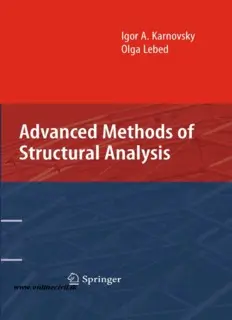Table Of Content
Advanced Methods of Structural Analysis
Igor A. Karnovsky Olga Lebed
(cid:129)
Advanced Methods
of Structural Analysis
123
IgorA.Karnovsky OlgaLebed
811NorthviewPl. CondorRebarConsultants,Inc.
CoquitlamBCV3J3R4 300-1128HornbySt.
Canada VancouverBCV6Z2L4
Canada
ISBN978-1-4419-1046-2 e-ISBN978-1-4419-1047-9
DOI10.1007/978-1-4419-1047-9
SpringerNewYorkDordrechtHeidelbergLondon
LibraryofCongressControlNumber:2009936795
(cid:2)c SpringerScience+BusinessMedia,LLC2010
Allrightsreserved.Thisworkmaynotbetranslatedorcopiedinwholeorinpartwithoutthewritten
permission of the publisher (Springer Science+Business Media, LLC, 233 Spring Street, New York,
NY10013, USA),except forbrief excerpts inconnection with reviews orscholarly analysis. Usein
connectionwithanyformofinformationstorageandretrieval,electronicadaptation,computersoftware,
orbysimilarordissimilarmethodologynowknownorhereafterdevelopedisforbidden.
Theuseinthispublicationoftradenames,trademarks,servicemarks,andsimilarterms,eveniftheyare
notidentifiedassuch,isnottobetakenasanexpressionofopinionastowhetherornottheyaresubject
toproprietaryrights.
Printedonacid-freepaper
SpringerispartofSpringerScience+BusinessMedia(www.springer.com)
Dedicatedto
TamaraL’vovna Gorodetsky
Preface
Theoryoftheengineeringstructuresisafundamentalscience.Statementsandmeth-
odsofthissciencearewidelyusedindifferentfieldsofengineering.Amongthem
are thecivilengineering,ship-building,aircraft,robotics,space structures,as well
asnumerousstructuresofspecialtypesandpurposes–bridges,towers,etc.Inrecent
years,evenmicromechanicaldevicesbecomeobjectsofstructuralanalysis.
Theory of the engineering structures is alive and is a very vigorous science.
This theory offers an engineer-designer a vast collection of classical methods of
analysisofvarioustypesofstructures.Thesemethodscontainin-depthfundamen-
tal ideas and, at the presenttime, they are developedwith sufficient completeness
and commonness,aligned in a well-composedsystem of conceptions,procedures,
and algorithms, use modern mathematical techniques and are brought to elegant
simplicityandperfection.
We now live in a computerized world. A role and influence of modern engi-
neering software for analysis of structures cannot be overestimated. The modern
computer programs allow providing different types of analysis for any sophisti-
catedstructure.Asthistakesplace,whatistheroleofclassicaltheoryofstructures
withitsin-depthideas,prominentconceptions,methods,theorems,andprinciples?
Knowing classical methods of Structural Analysis is necessary for any practical
engineer.Anengineercannotrelyonlyontheresultsprovidedbyacomputer.Com-
puter is a great help in modeling differentsituations and speeding up the process
of calculations, but it is the sole responsibility of an engineerto check the results
obtainedbyacomputer.Ifusersofcomputerengineeringsoftwaredonothavesuf-
ficient knowledge of fundamentals of structural analysis and of understanding of
physical theories and principal properties of structures, then he/she cannot check
obtainednumericalresultsandtheircorrespondencetoanadopteddesigndiagram,
aswellasexplainresultsobtainedbyacomputer.Computerprograms“...canmake
a good engineer better, but it can make a poor engineer more dangerous” (Cook
R.D, MalkusD.S, Plesha M.E (1989)Concepts and applicationsof finite element
analysis, 3rd edn. Wiley, New York). Only the knowledge of fundamental theory
of structuresallows to estimate and analyze numericaldata obtainedfrom a com-
puter;predictthe behaviorof a structure as a result of changinga design diagram
and parameters; design a structure which satisfies certain requirements; perform
serious scientific analysis; and make valid theoretical generalizations. No matter
vii
viii Preface
how sophisticated the structural model is, no matter how effective the numerical
algorithms are, no matter how powerful the computers are that implement these
algorithms,it is the engineerwho analyzesthe endresult producedfromthese al-
gorithms.Onlyanindividualwhohasa deepknowledgeandunderstandingofthe
structuralmodelandanalysistechniquescanproduceaqualitativeanalysis.
In1970,oneoftheauthorsofthisbookwasaprofessoratastructuralengineer-
ing university in Ukraine. At that time computerswere started to be implemented
in all fields of science, structural analysis being one of them. We, the professors
andinstructors,werefacingaseriousmethodicaldilemma:giventhenewtechnolo-
gies,howtoproperlyteachthestudents?Wouldwefirstgivestudentsastrongbasis
in classical structural analysis and then introducethem to the related software, or
would we directly dive into the software after giving the student a relatively in-
significantintroductiontoclassicalanalysis.Wedidnotknowtheoptimalwayfor
solvingthisproblem.Onthissubjectwehaveconductedseminarsanddiscussions
onaregularbasis.Wehaveusedthesetwomainteachingmodels,andmanydiffer-
entvariationsofthem.Theresultwassomewhatsurprising.Thestudentswhowere
firstgivenastrongfoundationinstructuralanalysisquicklylearnedhowtousethe
computersoftware,andwereabletogiveagoodqualitativeanalysisoftheresults.
Thestudentswhoweregivenabriefintroductiontostructuralanalysisandastrong
emphasisonthecomputersoftware,attheendwerenotabletoprovidequalitative
results of the analysis. The interesting thing is that the students themselves were
criticizingthelaterteachingstrategy.
Therefore, our vision of teaching structural analysis is as follows: on the first
step, it is necessary to learn analytical methods, perform detailed analysis of dif-
ferent structures by hand in order to feel the behavior of structures, and correlate
their behavior with obtained results; the second step is a computer application of
engineeringsoftware.
Authorswrotethebookonthebasisoftheirmanyyearsofexperienceofteaching
theStructuralAnalysisattheuniversitiesforgraduateandpostgraduatestudentsas
wellasonthebasisoftheirexperienceinconsultingcompanies.
This book is written for students of universities and colleges pursuing Civil or
StructuralEngineeringPrograms,instructorsofStructuralAnalysis,andengineers
anddesignersofdifferentstructuresofmodernengineering.
Theobjectiveofthebookistohelpareadertodevelopanunderstandingofthe
ideasandmethodsofstructuralanalysisandtoteachareadertoestimateandexplain
numericalresults obtainedby hand;this is a fundamentalstone for preparationof
readerfornumericalanalysisofstructuresandforuseofengineeringsoftwarewith
fullunderstanding.
ThetextbookoffersthereaderthefundamentaltheoreticalconceptsofStructural
Analysis,classicalanalyticalmethods,algorithmsoftheirapplication,comparison
ofdifferentmethods,andavastcollectionofdistinctiveproblemswiththeirdetailed
solution, explanation, analysis, and discussion of results; many of the problems
haveacomplexcharacter.Consideredexamplesdemonstratefeaturesofstructures,
theirbehavior,andpeculiaritiesofappliedmethods.Solutionofalltheproblemsis
broughttofinalformulaornumber.
Preface ix
Analyses of the following structures are considered: statically determinate and
indeterminate multispan beams, arches, trusses, and frames. These structures are
subjectedtofixedandmovingloads,changesoftemperature,settlementofsupports,
anderrorsoffabrication.Alsothecablesareconsideredindetail.
In many cases, same structure under different external actions is analyzed. It
allows the readerto be concentratedon one designdiagramand performcomplex
analysisofbehaviorofastructure.
Inmanycases,samestructureisanalyzedbydifferentmethodsorbyonemethod
in different forms (for example, Displacement method in canonical, and matrix
forms). It allows to perform comparison analysis of applied methods and see ad-
vantagesanddisadvantagesofdifferentmethods.
DistributionofMaterial inthe Book
Thisbookcontainsintroduction,threeparts(14chapters),andappendix.
IntroductionprovidesthesubjectandpurposesofStructuralAnalysis,principal
concepts,assumptions,andfundamentalapproaches.
Part 1 (Chaps. 1–6) is devoted to analysis of statically determinate structures.
Among them are multispan beams, arches, trusses, cables, and frames. Construc-
tion of influence lines and their application are discussed with great details. Also
thispartcontainsanalyticalmethodsofcomputationofdisplacementofdeformable
structures,subjectedtodifferentactions.Amongthemarevarietyloads,changeof
temperature,andsettlementsofsupports.
Part2(Chaps.7–11)isfocusedonanalysisofstaticallyindeterminatestructures
usingthefundamentalmethods.Amongthemaretheforceanddisplacementmeth-
ods(bothmethodsarepresentedincanonicalform),aswellasthemixedmethod.
Alsotheinfluencelinemethod(onthebasisofforceanddisplacementmethods)is
presented.Analysisofcontinuousbeams,arches,trusses,andframesisconsidered
indetail.
Chapter11 is devotedto matrix stiffnessmethodwhich is realized in the mod-
ern engineering software. Usually, the physical meaning of all matrix procedures
presentsseriousdifficultiesforstudents. Comparisonofnumericalproceduresob-
tainedby canonicalequationsand theirmatrix presentations,whichare appliedto
the same structure, allows trace and understandsmeaning of each stage of matrix
analysis.Thismethodisappliedforfixedloads,settlementofsupports,temperature
changes,andconstructionofinfluencelines.
Part3(Chaps.12–14)containsthreeimportanttopicsofstructuralanalysis.They
areplasticbehaviorofstructures,stabilityofelasticstructureswithfiniteandinfinite
numberofdegreesoffreedom,includinganalysisof structuresonthe basisofthe
deformabledesigndiagram(P–(cid:2)analysis),andthefreevibrationanalysis.
Each chapter contains problems for self-study. Answers are presented to all
problems.

